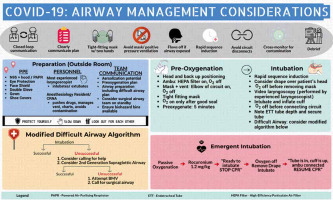Dear Editor,
The global pandemic caused by the outbreak of the novel coronavirus SARS-CoV-2 has brought about new concerns for the protection and safety of both patients and the healthcare workers who care for and support them. The protection of healthcare workers is of utmost importance and the Centres for Disease Control, the World Health Organisation, and the Anaesthesia Patient Safety Foundation (APSF) have all developed recommendations to minimise transmission of this pathogen from SARS-CoV-2-infected patients to healthcare providers. This graphic provides a summary of the recommendations of personal protective equipment (PPE), and precautions to be taken during procedures involving the airway, which are considered aerosol-generating procedures (AGPs) [1, 2].
Aerosol-generating procedures, which include intubation, non-invasive ventilation, tracheotomy, cardio-pulmonary resuscitation, manual ventilation prior to intubation, and bronchoscopy, are all associated with increased risk of SARS-CoV-2 transmission. Thus, special precautions must be taken when performing these procedures, which are the focus of this infographic [1–3]. Healthcare providers should wear N95 masks or utilise a Powered Air-Purifying Respirator (PAPR) when performing AGPs, noting that the PAPR provides superior protection and may be warranted for patients with known or suspected SARS-CoV-2 infection. Eye protection (goggles or face shield) and a long-sleeved, waterproof gown should also be worn. In addition, the APSF recommends utilising the double-glove technique, ensuring the performance of proper hand hygiene for donning and doffing of PPE and at any time that contamination may be suspected [2].
Based on the experience of intubating teams in the epicentre of the pandemic in Wuhan, mask ventilation should be avoided if possible due to the aerosolisation potential of the virus [4]. In regard to intubation, early intubation should be considered to avoid a crash intubation, leaving the healthcare team with inadequate time to appropriately don PPE. The most experienced anaesthesia professional should perform intubation, keeping in mind that the number of persons present in the room should be minimised and specific to the number needed to adequately care for and support the patient in need [2]. Proper disposal of intubation equipment should be planned for, and procedure room surfaces should be cleaned and disinfected promptly [1].





